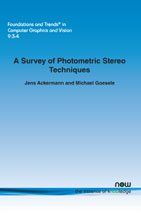A Survey of Photometric Stereo Techniques
By Jens Ackermann, TU Darmstadt, Germany, jens.ackermann@gris.informatik.tu-darmstadt.de | Michael Goesele, TU Darmstadt, Germany, michael.goesele@gris.informatik.tu-darmstadt.de
Abstract
Reconstructing the shape of an object from images is an important problem in computer vision that has led to a variety of solution strategies. This survey covers photometric stereo, i.e., techniques that exploit the observed intensity variations caused by illumination changes to recover the orientation of the surface. In the most basic setting, a diffuse surface is illuminated from at least three directions and captured with a static camera. Under some conditions, this allows to recover per-pixel surface normals. Modern approaches generalize photometric stereo in various ways, e.g., relaxing constraints on lighting, surface reflectance and camera placement or creating different types of local surface estimates. Starting with an introduction for readers unfamiliar with the subject, we discuss the foundations of this field of research. We then summarize important trends and developments that emerged in the last three decades. We put a focus on approaches with the potential to be applied in a broad range of scenarios. This implies, e.g., simple capture setups, relaxed model assumptions, and increased robustness requirements. The goal of this review is to provide an overview of the diverse concepts and ideas on the way towards more general techniques than traditional photometric stereo.
A Survey of Photometric Stereo Techniques
Reconstructing the shape of an object from images is an important problem in computer vision that has led to a variety of solution strategies. This monograph focuses on photometric stereo, that is, techniques that exploit the observed intensity variations caused by illumination changes to recover the orientation of the surface. In the most basic setting, a diffuse surface is illuminated from at least three directions and captured with a static camera. Under some conditions, this allows to recover per-pixel surface normals. Modern approaches generalize photometric stereo in various ways; for example, relaxing constraints on lighting, surface reflectance and camera placement, or creating different types of local surface estimates.
Starting with an introduction for readers unfamiliar with the subject, A Survey of Photometric Stereo Techniques discusses the foundations of this field of research. It then summarizes important trends and developments that have emerged in the last three decades. The focus is on approaches with the potential to be applied in a broad range of scenarios. This implies, for example, simple capture setups, relaxed model assumptions, and increased robustness requirements. This is an ideal reference for anyone looking for an understanding of the diverse concepts and ideas around this topic and how we can move towards more general techniques than traditional photometric stereo.
